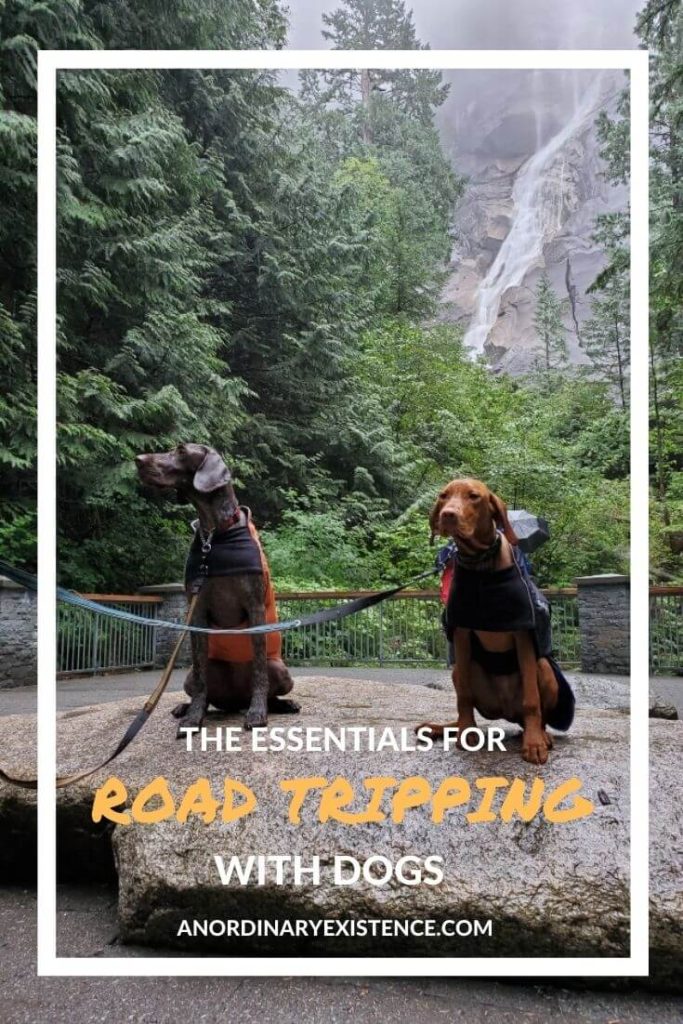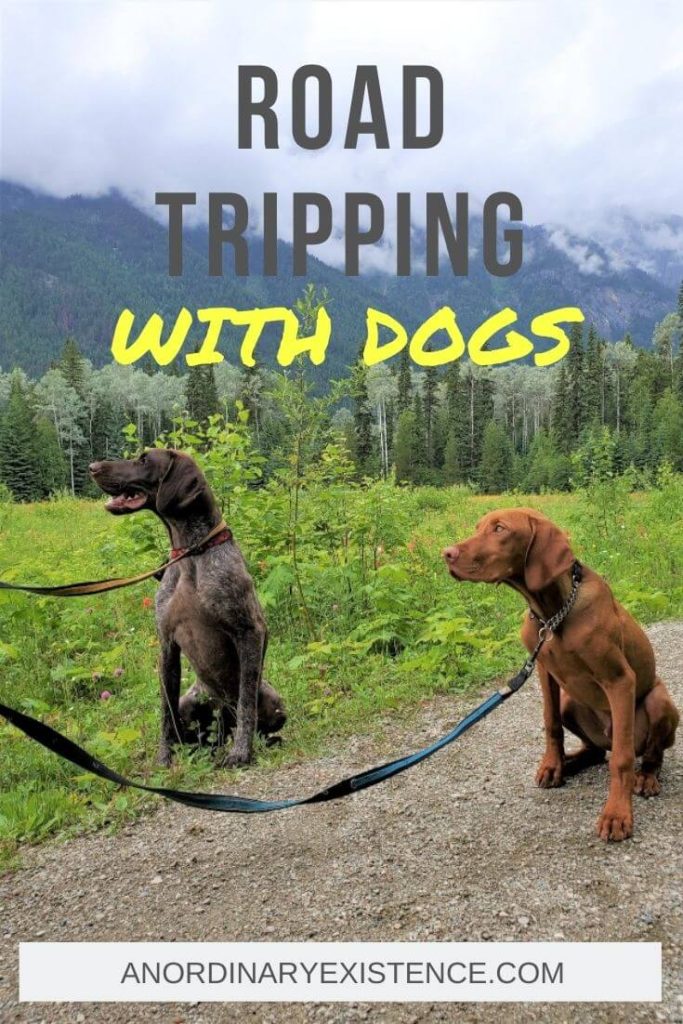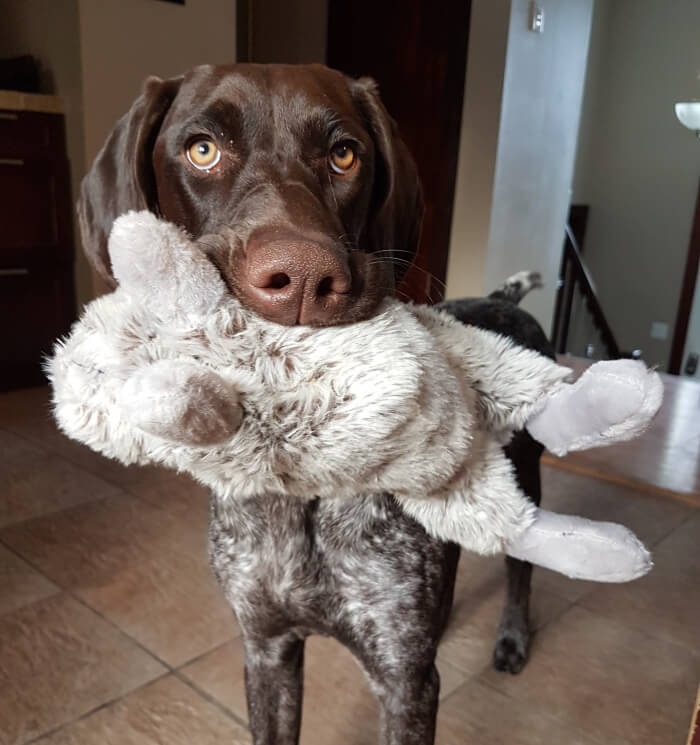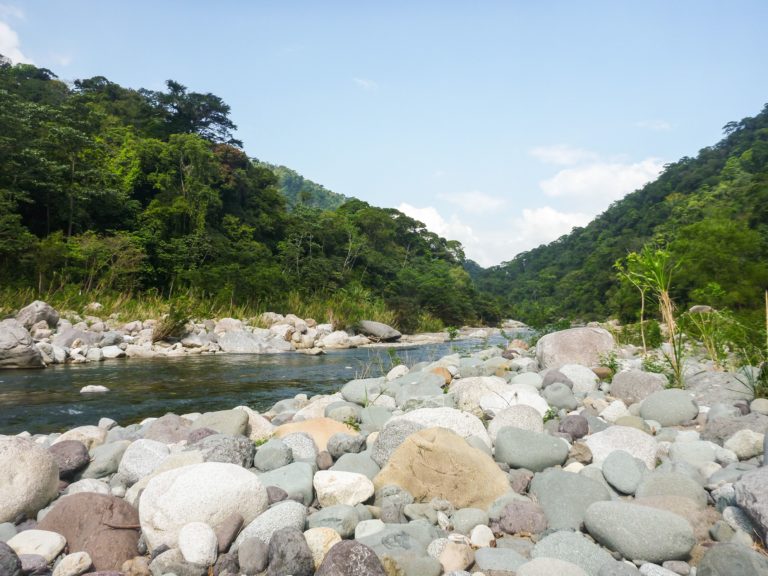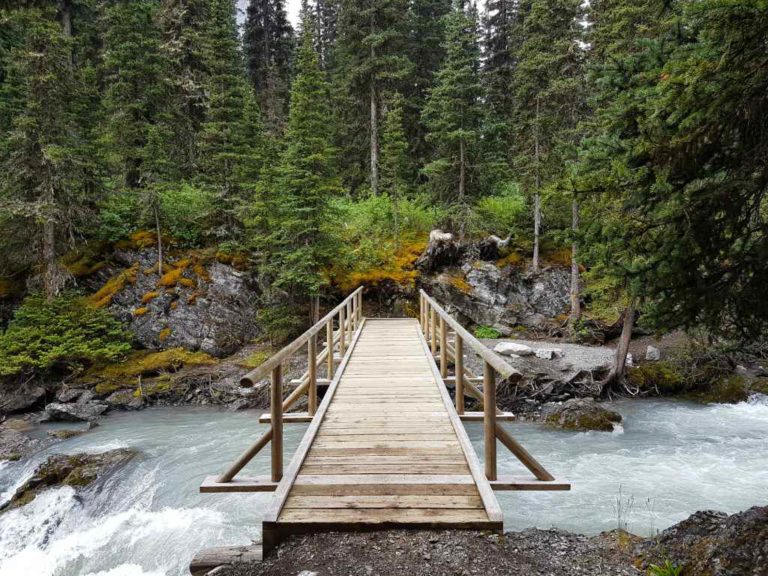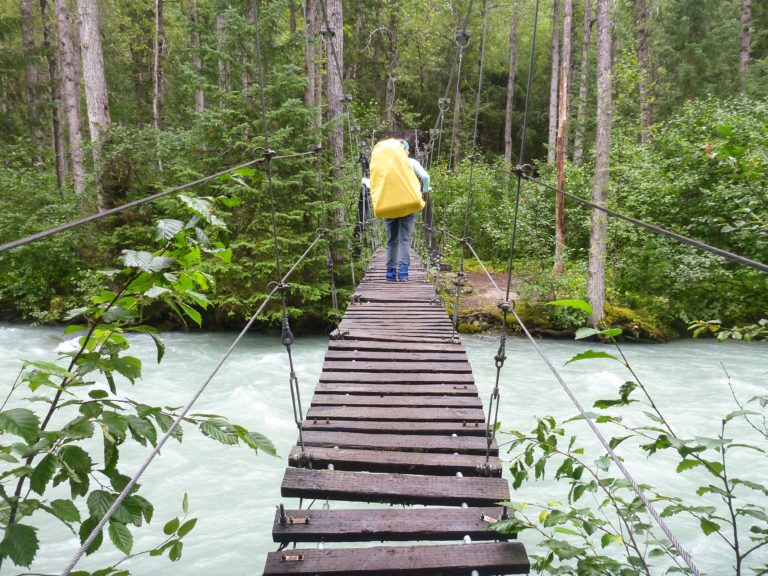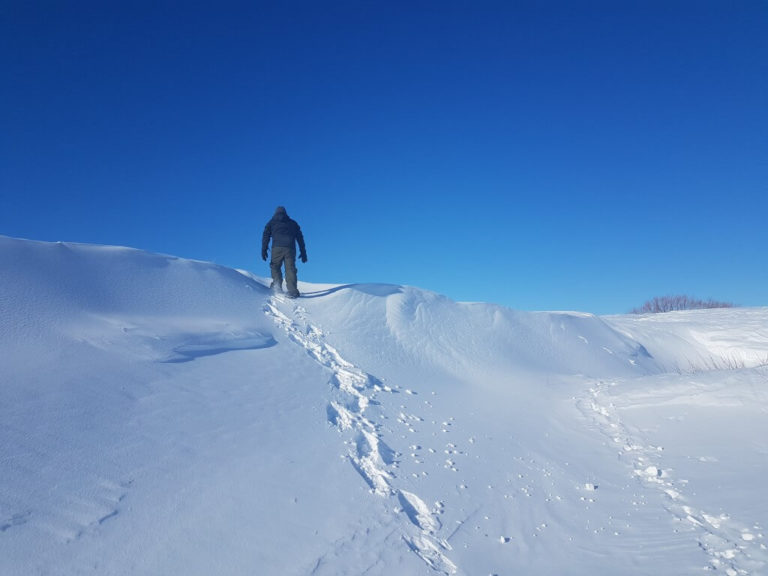ROAD TRIPPING WITH A DOG: THE ESSENTIALS
This post may include affiliate links. As an Amazon Associate I earn from qualifying purchases. Find more info in my privacy policy.
Are you planning a road trip with your dog? In my ~ totally biased ~ opinion, they make the best travel companions. But taking your furry friend along requires a little more thought than simply throwing them in the car and hitting the pavement.
After spending a ton of time on the road with our pups and learning many lessons, I thought I’d put together my list of essential items and my best tips for road-tripping with a dog, which will make your adventure as stress- and pain-free as possible.
Below, you’ll find a broken-down list of what to take and why, my gear recommendations and the favourites we use, and tips and tricks to make every aspect of the trip just a little more delightful.
Let’s get started.
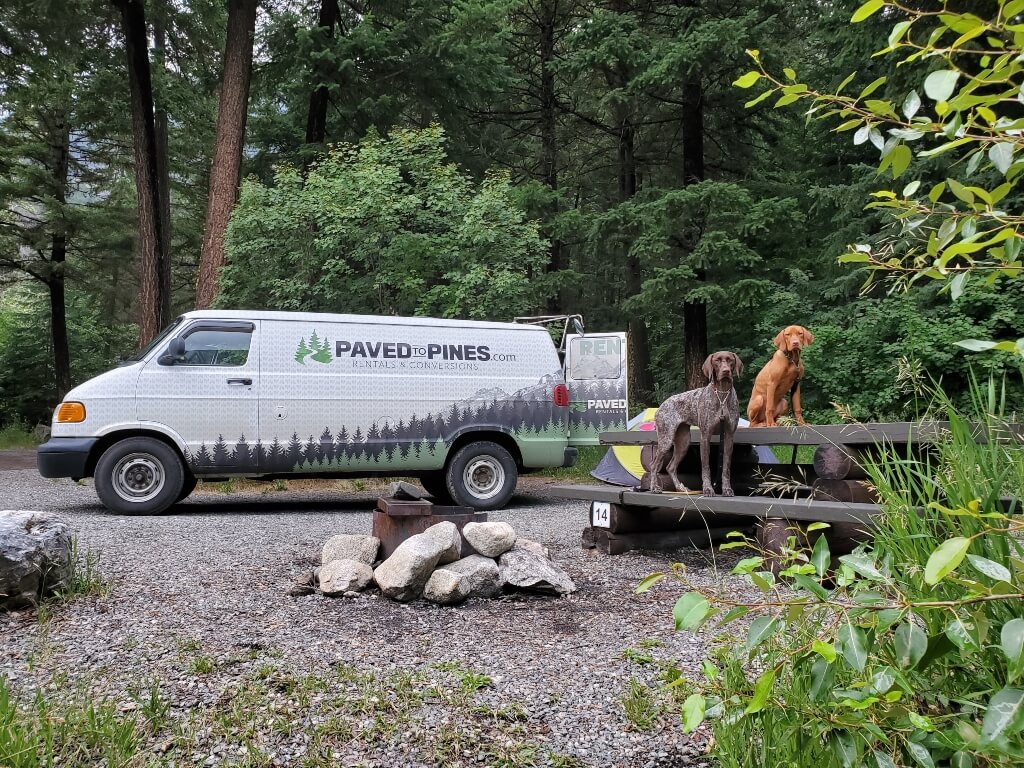
THE ESSENTIALS
IMPORTANT DOCUMENTS
Having up-to-date documents along is crucial. Depending on your plans, you may need to show records at border crossings, at boarding facilities, and at any park or facility where dogs congregate. You may need vaccination records, their medical history, or a certificate of health from your vet. Be sure to check rules and regulations before heading out, so you know what’s required.
It’s also handy to have along your pet’s documents and other information in the case that they are injured, lost, or stolen. In an emergency, an unfamiliar vet will appreciate having access to vaccination/medical records as well as the contact information of your regular vet in case they have questions about your pet’s history. Keep a copy of your dog’s microchip number handy for any situations where you need to locate them.
Copies of this information can be stored in the cloud and accessed when needed from the road, though it is handy to have a paper copy along for those times you may not have service.
WHAT TO TAKE:
- Vaccination records and medical history documents
- Health clearance or medical certificate from your vet, if required
- Microchip number
- Information and emergency numbers of your regular vet
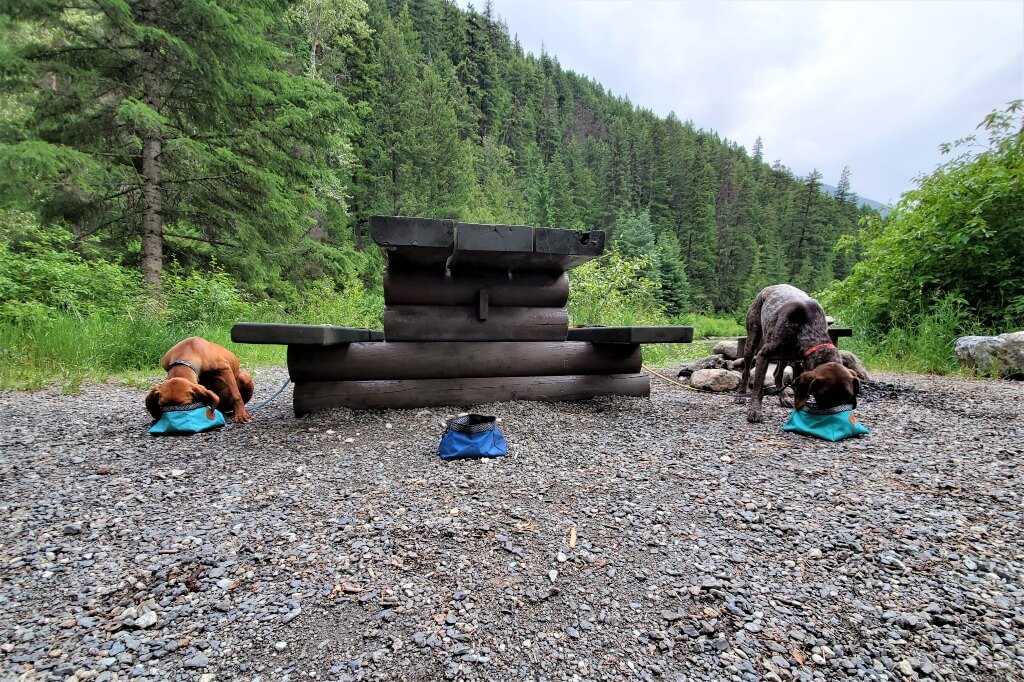
KEEPING THEM FED AND WATERED
Making sure your dog stays well-fed and hydrated during a road trip takes a little forethought and planning. Be sure to bring enough food along for the duration of the journey, or ensure you can acquire more along the way. We’ve learned the hard way that relying on pet stores to have your brand of dog food in stock isn’t always the best plan. We now make sure to stock up ahead of time and take along what we’ll need. Most pet food manufacturers recommend storing dry dog food in the original packaging. Still, if you’re concerned about the bag ripping, tipping, or spilling (been there!), you might want to consider putting it inside a hard-sided container to keep it protected. We also use the Wilder Dog Doggie Bag for storing smaller amounts of food on shorter trips. I love that it shrinks down as the food gets used and packs away easily. Don’t forget to bring along a measuring cup to keep track of how much your dog is eating.
You’ll also need dishes or bowls for food and water. I find the stainless-steel dishes we usually use at home to be too bulky for road trips, so we use collapsible fabric bowls. We’ve also tried the silicone folding dishes but found they don’t stay open well enough with an enthusiastic dog and end up collapsing and leaving a mess. I prefer the Wilder Dog Backpacking Bowls, which are lightweight, fold up to nothing, and can be used for food or water. We generally only fill a water dish during longer pit stops or once we’ve stopped moving for the night. For quick water breaks on the go, we use Gulpy Water Dispensers – basically a bottle and bowl in one. They’re fast, easy, and I find that we waste way less water than when we have to dump what’s left in the dish before hitting the road again.
WHAT TO TAKE:
- Collapsible dishes for food and water
- Food bag or storage container
- Food
- Scoop/measuring cup
- Water dispenser
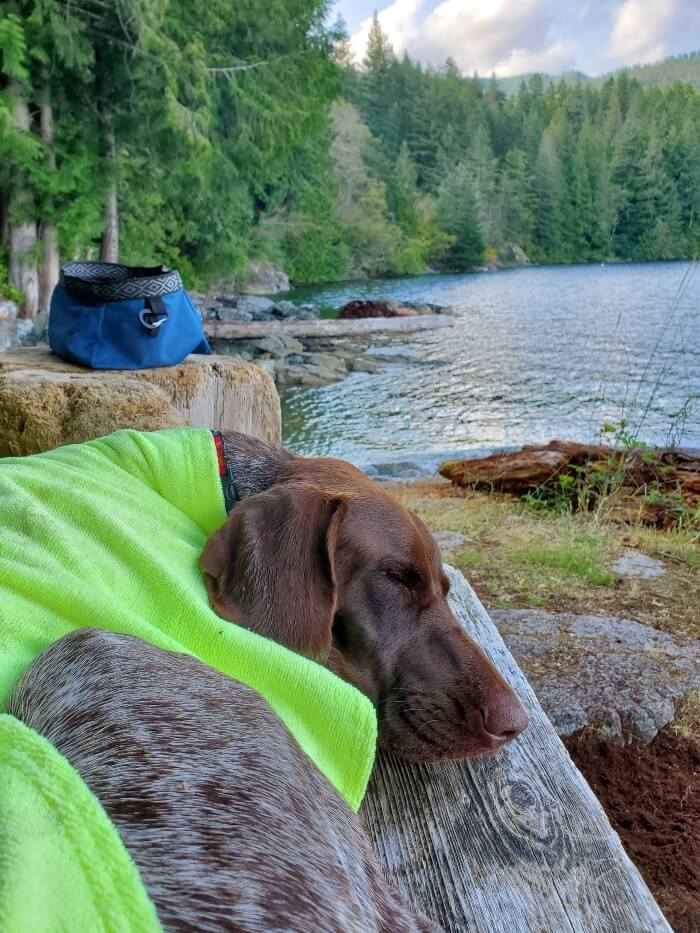
RIDING IN COMFORT
Keeping your dog safe and comfortable is essential on road trips. A comfortable, happy dog will likely spend the majority of the trip sleeping peacefully or quietly watching the action out the window. An uncomfortable dog will likely spend the majority of the trip antsy and whining. Make sure your pup has enough room to lay down, stretch out, and turn around easily.
There are varying opinions on the best way to keep your dog safe while driving, so do some research and decide what works best for you. Keeping them secured, off your lap, and not able to distract you is probably the best course of action. You can get crash-tested crates, but beware that there isn’t much of a regulated industry standard for pet transportation safety. So do some research before you drop hundreds on a kennel that may be no safer than the one you found used for a quarter of the price. Another option is using a seatbelt clip and harness combo. Again, make sure you’re using the proper harness and clip system for your dog. Because we travel with two dogs, we choose to let them free roam in an area of the vehicle with a divider to keep them contained. The best option for you will depend on the dog’s size (and personality), and the vehicle’s type and makeup.
Beyond keeping them secure and safe, you’ll also want to make sure they are comfortable. Don’t forget blankets, a crate mat, or a dog bed. Regulate the temperature of the vehicle as best you can and never leave a dog unattended in a hot car.
You should also be prepared to deal with any potential messes while on the road. If your dog has an accident or gets sick in the car, you’ll want to be able to deal with it as soon as possible, which could be on the side of the road. Have along paper towels, disposal bags, and cleaner. I like Nature’s Miracle enzyme cleaner and take along a supply of empty resealable food packaging to use as garbage bags. The mess goes in there and then into the next available trashcan. The likelihood of an accident is also a good reason to have some extra blankets along in case you need to switch out a messy one for a clean one.
WHAT TO TAKE:
- Method of securing the dog (crate, seatbelt strap/harness, divider)
- Bed/Crate Mat
- Blankets
- Paper Towel
- Bags to use for trash and messes
- Cleaner (like Nature’s Miracle)
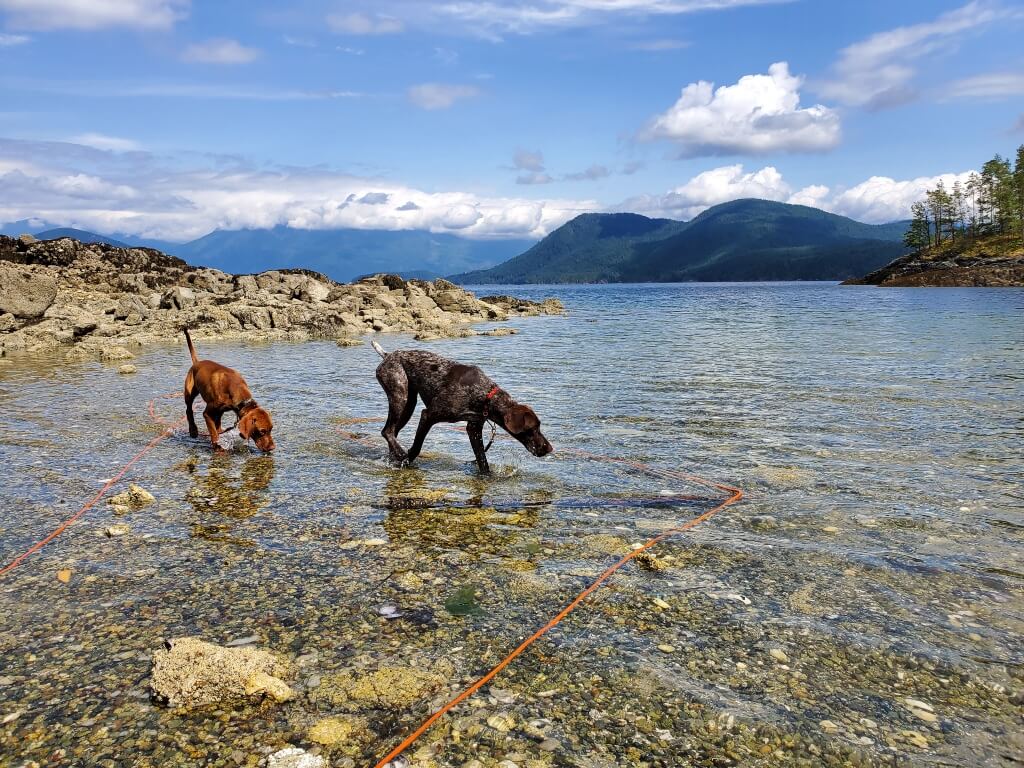
KEEPING THEM BUSY
A bored pup is a bad pup. Especially when they are going long stretches being cooped up in a vehicle and maybe not getting as much exercise as they usually would. Don’t forget to take along their favourite toys, treats, and chewies to keep them occupied – otherwise, it might be a seat cover or door handle that gets the brunt of their boredom. Dogs are resourceful like that.
Some of our favourites are deer antlers, West Paw chew toys, and long-lasting treats like bully sticks, yak chews, and stuffed kongs. Mind games like puzzles and snuffle mats can also come in handy. Gus is always happy to spend hours decapitating and de-stuffing fabric toys, so we take along a few of those to sacrifice along the way. Take whatever your dog loves enough to keep them occupied.
WHAT TO TAKE:
- Chewies
- Toys
- Treats
- Mind games
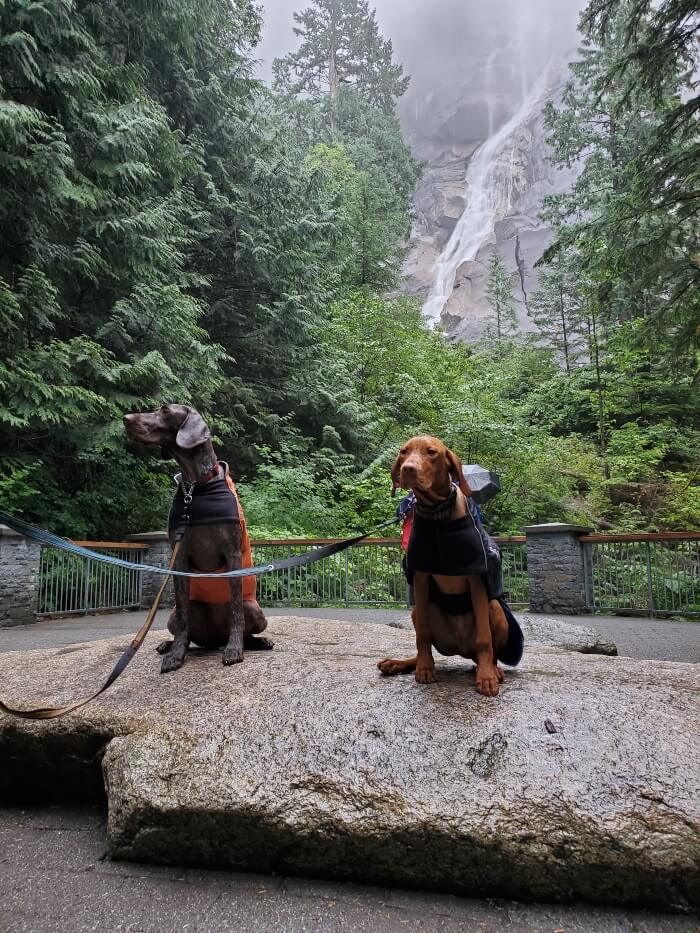
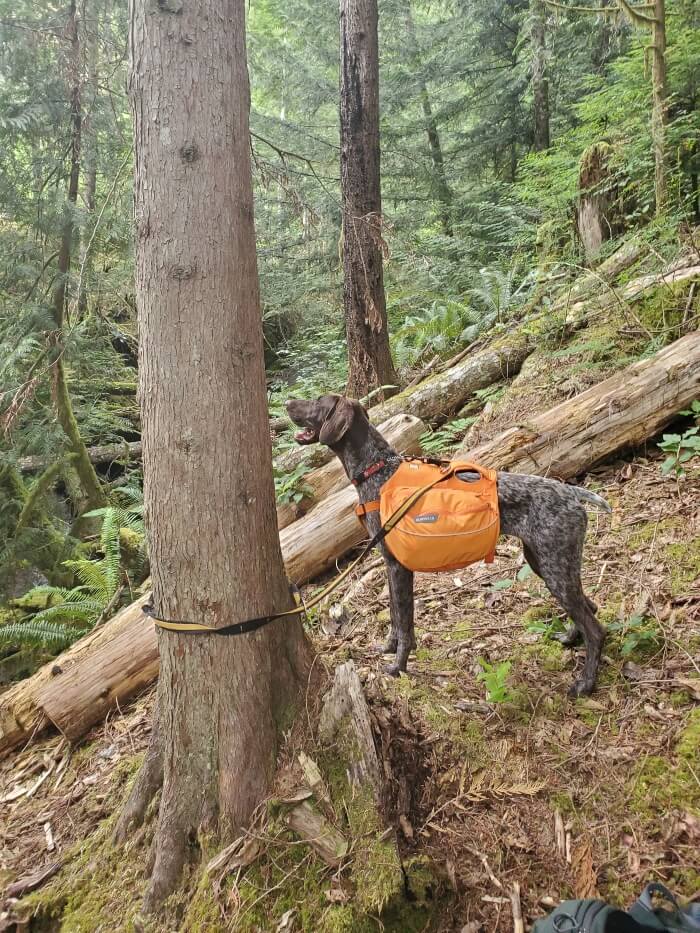
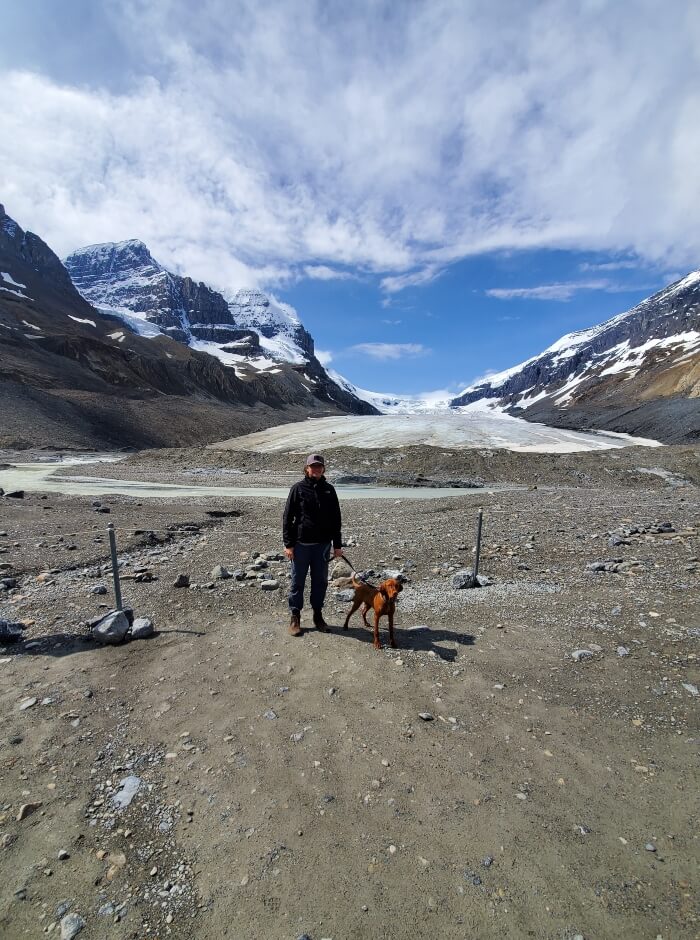
GEAR FOR PIT STOPS AND ADVENTURES
I highly recommend planning pit stops around dog-friendly activities like visits to off-leash dog parks or exploring pet-friendly hiking trails. These are great ways to tire your dogs out and let them get some physical activity worked into their day. If gas stations are your only options, try to find ones with larger open spaces where you can both stretch your legs a little.
You’ll want to have along the basics like a leash, collar or harness, and poop bags. I like multi-use leashes that convert from handheld to waistbelt-style when needed. We use the Kurgo Quantum 6-in-1 leash, which can be used as a standard leash, waistbelt, or as a tether to attach your dog to a stationary object like a tree or park bench. For longer trips, we also often take long lines, which can give your dog a little more freedom of movement and be used to run through training drills that aren’t possible on a six-foot leash. Your dog should also have a collar with an up-to-date ID tag that has all the necessary info on it. A GPS collar or tracker that attaches to a regular collar can also offer additional peace of mind if you’re worried about your pooch making a break for it.
Raincoats and paw towels are handy for keeping the elements out of the vehicle and minimizing that wet-dog smell on rainy days. Another great item to have along is a soaker robe, which will quickly dry off a wet dog after a swim or can be used wet to cool them off when it’s hot. We’re big fans of Chilly Dogs coats and towels and found we got quite a bit of use out of them on our extra-rainy road trip across western Canada last year. Our favourites are the Alpine Blazer, the Soaker Robe, and the Soaker Paw Towel.
For longer hikes, having a backpack for your dog can help tire them out faster, gives them a job to do, and lightens your load a bit. Ruffwear packs are the gold standard and don’t come cheap, but if you’ll get lots of use out of it, I highly recommend the brand. I also like to take along Musher’s Secret paw wax to protect their pads from rough trails and hot pavement. A pet first aid kit is also a must. Adventure Medical Kits and My Medic have pet versions, but you can also DIY your own. I like to have a larger in-the-car kit with a decent supply to last the trip, and also a smaller kit I can carry on hikes. A supply of peroxide (to induce vomiting) and Benadryl (to treat allergic reactions) are great to have along for those situations where Fido gets into something they shouldn’t. Talk to your vet about the appropriate dosage for your dog and write it down before you go.
WHAT TO TAKE:
- Leash
- Collar
- Harness
- Poop Bags
- Coats
- Paw towels
- Backpack
- Musher’s Secret
- First aid kit
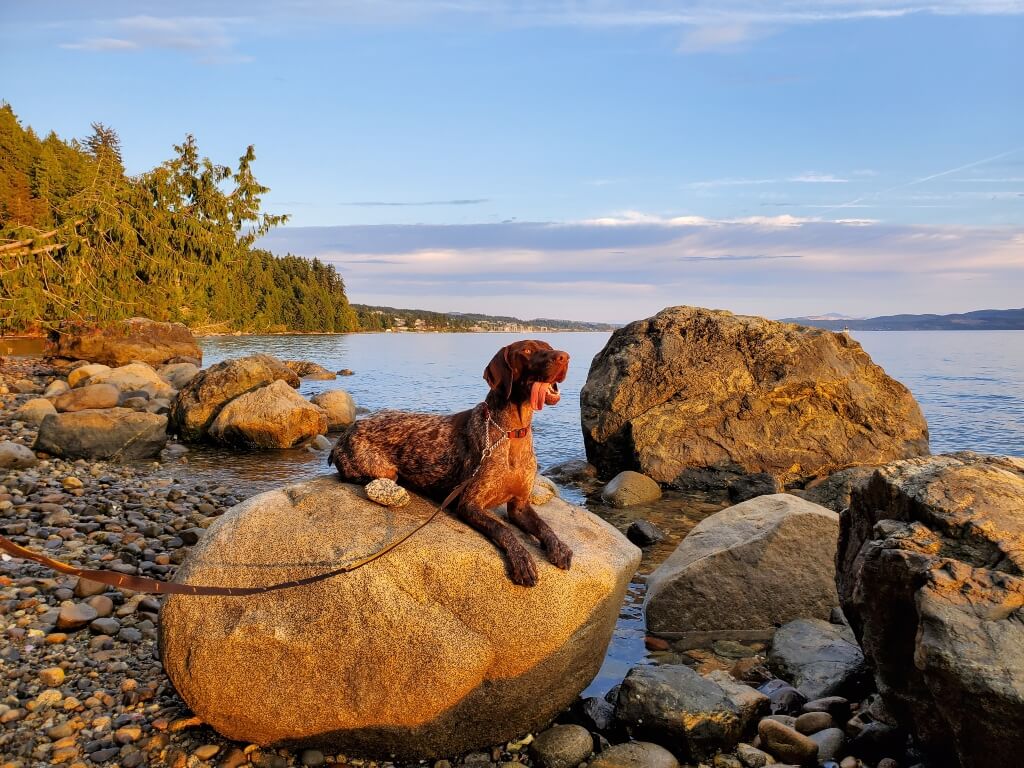
AT THE END OF THE DAY
Once you’re done putting on miles for the day, you’ll want to be able to relax wherever you happen to be overnighting. If you’re staying in hotels, you’ll be able to re-use items that you’ve already been using on the trip – like the dog beds, food and water bowls, toys and treats mentioned above.
If you’re camping out, there are a few extras you’ll likely want to take along to make your time in camp a little more enjoyable. A tie-out can help secure your dog while you’re busy setting up or cooking dinner. If you don’t want to get your plush dog bed or crate mat dirty, camp-cot-style dog beds are handy. Not only do they minimize the mess, but they also keep your dog up off the ground and more comfortable.
If your dog will be outside for extended periods, ensure you have a plan for keeping them sheltered from the rain and sun. A tarp or shelter can help with this (and create extra storage space for items you don’t want to keep in the vehicle overnight).
WHAT TO TAKE:
- Tie outs
- Camp beds
- Rain shelter or tarp
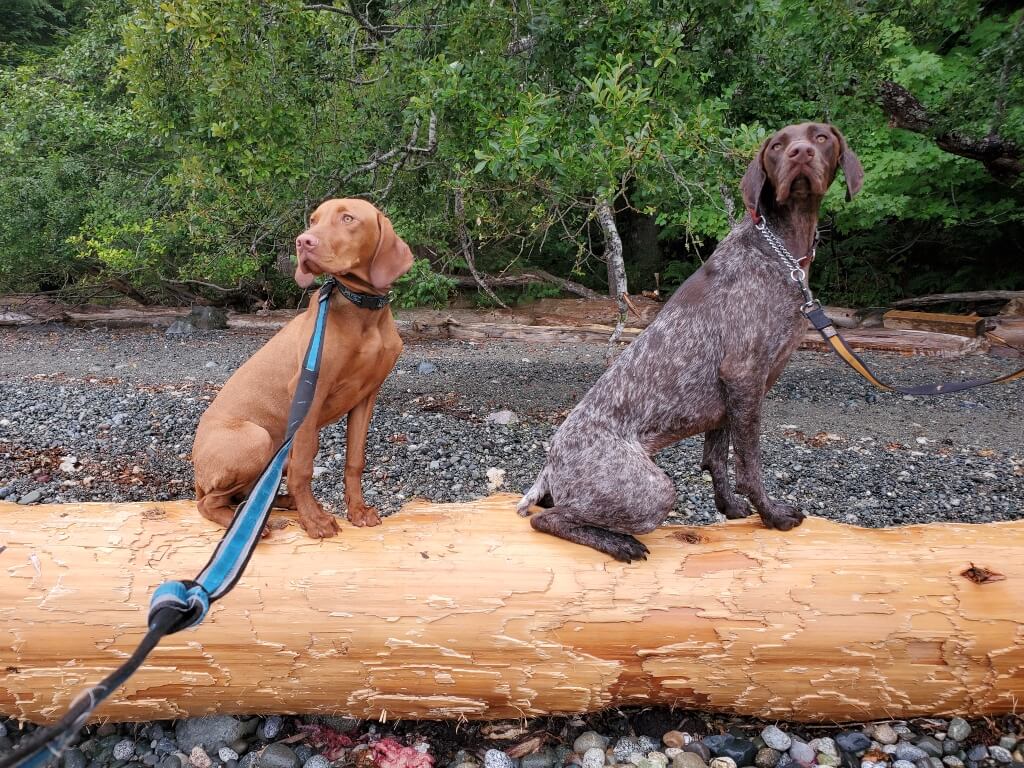
GENERAL TIPS AND TRICKS FOR ROAD TRIPPING WITH A DOG
Below, you’ll find my top tips for road tripping with dogs – both before you go and once you’re on the road. As always, I learned these lessons the hard way, so you don’t have to.
BEFORE YOU GO
Start slow. Before heading out on full-day or multi-day trips, take time to get your dog used to the car. Some dogs are nervous travellers, suffer from motion sickness, or just straight hate vehicles. A slow, consistent, positive introduction is the best way to ensure the road trip will be enjoyable for everyone.
Have the training basics down. All the new experiences and places that come with a road trip will be much easier to navigate if your dog knows their basic commands. Sit, stay, heel, wait, leash manners, and loading and unloading from the vehicle are all things that will come in handy. Having said that, road trips are also great for socialization and training in different settings. Gus was only five months old when we did a 2-week road trip across western Canada. He certainly wasn’t fully trained, but we had done one puppy class session before we left, so he had at least a basic understanding of the commands.
Do a trial run. Pack the car and pretend you’re stopping for the night. Do you have what you need? Can you access things without having to tear apart the whole car? Is there a rhyme or reason to how you organized things? Work the kinks out before you’re standing in the rain in some random parking lot listening to your hungry dog whining while you frantically search for that food dish you could have sworn you put RIGHT THERE this morning…
Set up a system. Run through the various scenarios in your head: who stays with the dogs while the humans get food, fuel up the car, or take bathroom breaks? Where are they while you’re checking into a hotel or campground or setting up camp? Do you have a way to keep them safe and comfortable while you’re taking care of business? Thinking about these things ahead of time can save a lot of stress while you’re on the road.
Plan ahead. Look for dog parks, dog-friendly walking trails, hikes, etc. before you go. Make sure dogs are allowed at the campgrounds or hotels where you’ll be staying. Even if you don’t have a set-in-stone itinerary, having a rough idea of what’s available to you and what’s off-limits will make for a smoother trip.
Have everything up to date. Check when your dog is due for vaccines or a health check and have these done prior to heading out. Make sure any necessary documents are current.
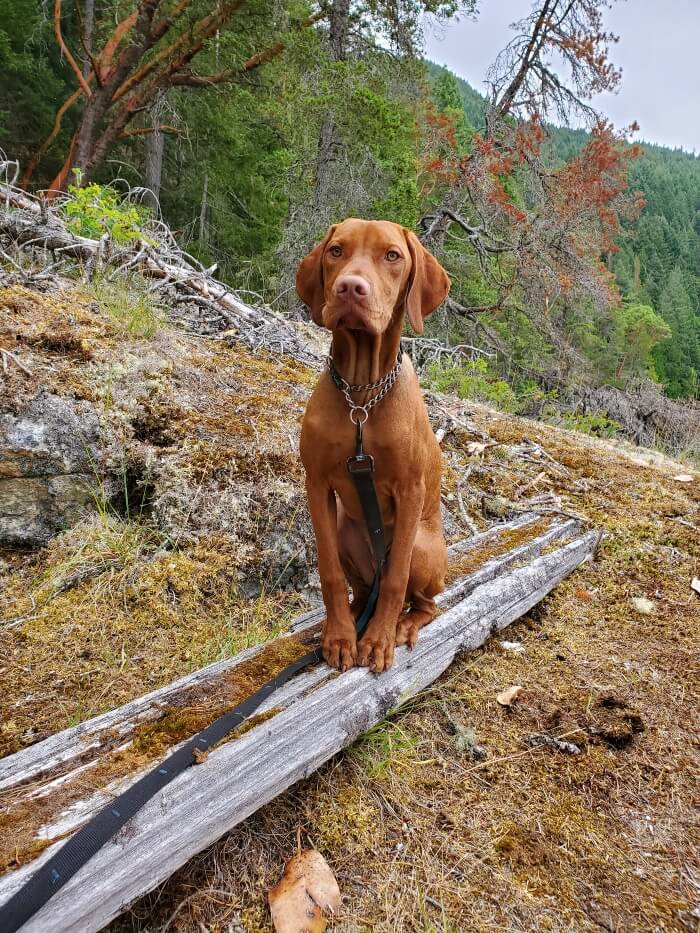
WHILE YOU’RE ON THE ROAD
Take regular breaks. Let your dog stretch their legs every 2-3 hours, more often for younger pups. Make sure they have time to do their business and burn off some energy. Offer water at every pit stop to be sure they’re staying hydrated.
Try to keep a routine. For multi-day trips, try to feed at regular times. If they tend to get car sick, try not to feed them right before heading out and allow some time for them to digest.
Keep them occupied. Taking a variety of their favourite toys and treats and rotating them often will help keep them engaged and entertained.
Give them a chance to burn some energy. Plan longer pit stops around dog parks and hiking trails where they’ll have the opportunity to stretch their legs and work out some of that pent-up energy.
Don’t forget about mental stimulation. Working their brain is a great way to tire out a dog. During pit stops, take a few minutes to run through training drills, teach them a new trick, or make an obstacle course out of whatever is available (weave trees, walk across park benches, or use a boulder as a sit-stay platform). Even letting them sniff around and explore a new-to-them place will help tire their brains.
Have patience. Having a dog along means you’re likely not going to move as fast as you might be used to. You may also find yourself dealing with unexpected messes to clean up or a dog who decides they aren’t going to listen that day. Stay patient, enjoy the ride, and focus on the positives that dogs bring to a road trip – like the companionship and motivation to get out of the car and move every once in a while.
Check out my Road Trip Essentials post for all my general road trip recs.
